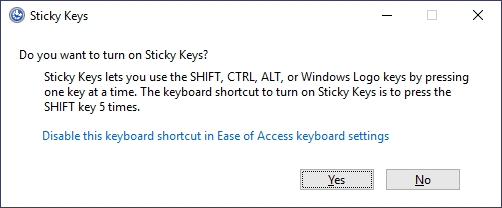Sticky Keys
To establish persistence using Sticky Keys, we will abuse a shortcut enabled by default in any Windows installation that allows us to activate Sticky Keys by pressing SHIFT 5 times.
After inputting the shortcut, we should usually be presented with a screen that looks as follows:

After pressing SHIFT 5 times, Windows will execute the binary in
C:\Windows\System32\sethc.exe.If we are able to replace such binary for a payload of our preference, we can then trigger it with the shortcut. Interestingly, we can even do this from the login screen before inputting any credentials.
A straightforward way to backdoor the login screen consists of replacing
sethc.exewith a copy ofcmd.exe.That way, we can spawn a console using the sticky keys shortcut, even from the logging screen.
To overwrite
sethc.exe, we first need to take ownership of the file and grant our current user permission to modify it.Only then will we be able to replace it with a copy of
cmd.exe. We can do so with the following commands:
takeown /f c:\Windows\System32\sethc.exe
SUCCESS: The file (or folder): "c:\Windows\System32\sethc.exe" now owned by user "PURECHAOS\Administrator".
icacls C:\Windows\System32\sethc.exe /grant Administrator:F
processed file: C:\Windows\System32\sethc.exe
Successfully processed 1 files; Failed processing 0 files
copy c:\Windows\System32\cmd.exe C:\Windows\System32\sethc.exe
Overwrite C:\Windows\System32\sethc.exe? (Yes/No/All): yes
1 file(s) copied.After doing so, lock your session from the start menu:
You should now be able to press SHIFT five times to access a terminal with SYSTEM privileges directly from the login screen:

Utilman
Notice that this registry key has no equivalent in HKLM, making your backdoor apply to the current user only.
After doing this, sign out of your current session and log in again, and you should receive a shell (it will probably take around 10 seconds).
Utilman is a built-in Windows application used to provide Ease of Access options during the lock screen:
When we click the ease of access button on the login screen, it executes
C:\Windows\System32\Utilman.exewithSYSTEMprivileges. If we replace it with a copy ofcmd.exe, we can bypass the login screen again.To replace
utilman.exe, we do a similar process to what we did withsethc.exe:
Last updated